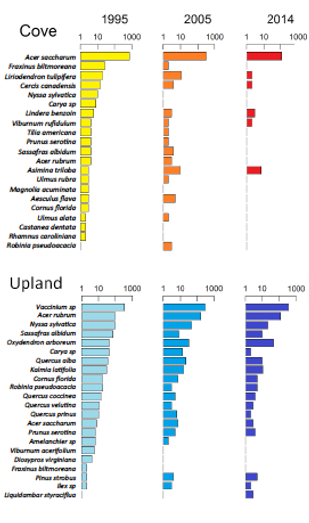
Assessing Ecological Resiliency in Two Adjacent Forest Communities on the Cumberland Plateau
Measuring the impacts of climate change and anthropogenic disturbances on plant communities has become a recent focus in management and conservation. The concepts of ecological resilience and resistance, the ability of a disturbed system to spring back to its original state or to resist change, can be used to assess community stability. Landscape-level resilience may be predicted by factors such as topographic variability, geological heterogeneity, and landscape connectivity. However, not all communities within a landscape may respond to disturbances in the same way, as they may consist of different species assemblages with varying life histories. The southern Cumberland Plateau, thought to be part of a highly resilient landscape, is characterized by two distinct plant communities. Cove and upland plant communities have contrasting species assemblages reflecting different underlying features in geology and topography. These adjacent forested communities experience the same disturbance regimes and are not dispersal-limited between one another.

Using long-term plots established in and adjacent to Dick Cove on the Domain of the University of the South, we have examined 20 years of change within these two forest communities. We conclude that cove systems are less resistant than upland systems in retaining their composition and structure. Our research suggests that simple methods to account for ecological resilience may overlook community-level differences within a landscape.
Publications:
-
Evans, J.P., *C.A. Oldfield, and *J.L. Reid. 2019. Differential resistance to tree species loss between two dominant communities in a resilient southeastern landscape. Natural Areas Journal 39:182-188. Blog Feature
-
*Reid, J.L., J.P. Evans, J.K. Hiers, and *J.B.C. Harris. 2008. Ten years of forest change in two adjacent communities on the southern Cumberland Plateau. Journal of the Torrey Botanical Society 135:224-235.






